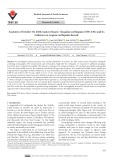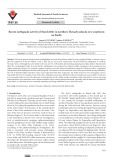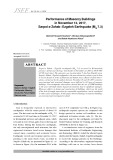
Seismic hazard
-
Herein, a combined analysis of Global Navigation Satellite System-derived strain rate maps, in accordance with recent seismicity, was presented to reveal that the N-S extension is accommodated primarily by strike-slip faulting of the İzmir-Balıkesir Transfer Zone (İBTZ), where a counter clockwise rotation (~25–100°/Myr) along the vertical axis is dominant. The results indicated that strike-slip segments within the İBTZ show variable transport sense and amount of slip along them, and they connect by hard linkage relay ramps with the dip to oblique slip normal faults.
 18p
18p  tanmocphong
tanmocphong
 29-01-2022
29-01-2022
 19
19
 1
1
 Download
Download
-
The southern part of the Western Anatolia Extensional Province is governed by E-W-trending horst-graben systems and NW-SE-oriented active faults. The NW-striking Yatağan Fault is characterised by an almost pure normal sense of motion with a minor dextral strike slip component. Although the settlements within the area have been affected by several earthquake events since ancient times (~2000 BCE), the earthquake potential and history of the Yatağan Fault has remained unknown until a few years ago.
 21p
21p  tanmocphong
tanmocphong
 29-01-2022
29-01-2022
 14
14
 1
1
 Download
Download
-
We have investigated the time-dependent seismicity model of the earthquake occurrence on a regional basis through the North Anatolian Fault Zone (NAFZ). To that end, the studied region has been subdivided into 7 seismogenic zones considering the seismotectonic criteria, and then regional time and magnitude predictable (RTIMAP) model has been performed. Intervened times and magnitudes of main shocks produced in each zone have predictive properties defined by the RTIMAP.
 20p
20p  tanmocphong
tanmocphong
 29-01-2022
29-01-2022
 30
30
 1
1
 Download
Download
-
We investigated rupture geometry, size, and slip distribution of October 30, 2020, Samos (Sisam)–Kuşadası earthquake combining seismographs, GPS measurements, and SAR analysis. Right after the earthquake, we measured 13 additional campaignbased GPS sites to intensify the available GPS network consisting of 10 continuous stations. We combined all available seismographs to have the best possible accuracy for mainshock and aftershock hypocenter locations. We compiled all available seismic profiles and integrated them using high-resolution bathymetry to map seismically active faults.
 11p
11p  tanmocphong
tanmocphong
 29-01-2022
29-01-2022
 14
14
 1
1
 Download
Download
-
A geological interpretation of the faulting mechanism is also proposed. The existence of a new unknown source in an intermontane area is problematic. The role of inherited alpine structures seems more important today than in the past. The strike of the two new seismogenic sources, responsible for the two strongest events of the 2021 earthquake succession, differs from the previously known active faults. This forces us to reconsider older views on the direction of development of active faults and the orientation of the stress field.
 11p
11p  tanmocphong
tanmocphong
 29-01-2022
29-01-2022
 24
24
 2
2
 Download
Download
-
Five accredited Tsunami Service Providers (TSPs) run by IPMA (Portugal), CENALT (France), INGV (Italy), NOA (Greece), and KOERI (Turkey), and several national centers monitor the seismicity and provide tsunami alerts in the framework of the UNESCO Tsunami Early Warning and Mitigation System in the North-eastern Atlantic, the Mediterranean and connected seas (NEAMTWS).
 16p
16p  tanmocphong
tanmocphong
 29-01-2022
29-01-2022
 17
17
 1
1
 Download
Download
-
Post-earthquake observations showed that the use of URM buildings in the area with high relative hazard of seismicity lead to significant damages. Moreover, defects in design and construction of buildings, which was the result of the lack of enough supervision by responsible organizations, can be considered as other causes of damages. In this paper, observed damages in masonry buildings are presented and investigated in detail.
 17p
17p  meriday
meriday
 20-04-2019
20-04-2019
 11
11
 0
0
 Download
Download
-
Whereas current building codes legally apply to seismic design of tall buildings, their prescriptive provisions do not adequately address many critical aspects. Performance-based engineering provides a desirable alternative.
 19p
19p  tranduyphung
tranduyphung
 24-08-2011
24-08-2011
 194
194
 17
17
 Download
Download


















